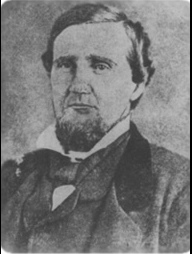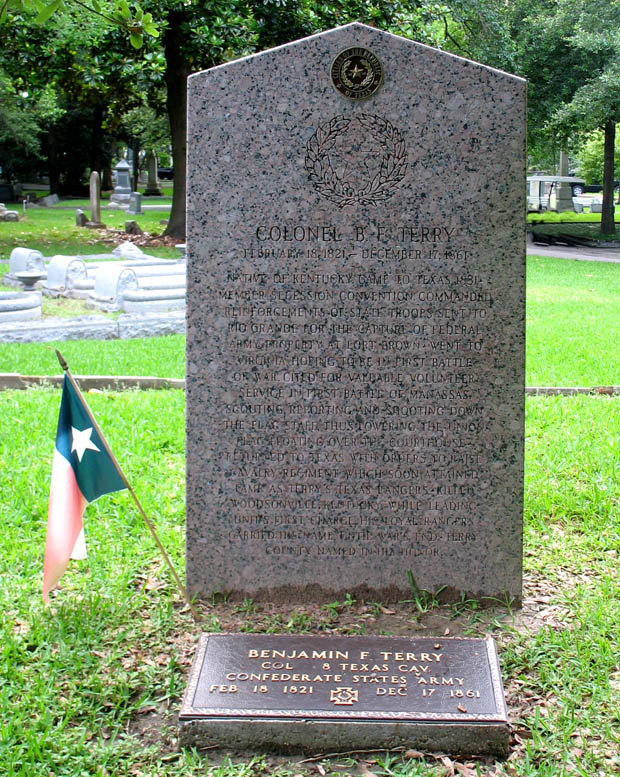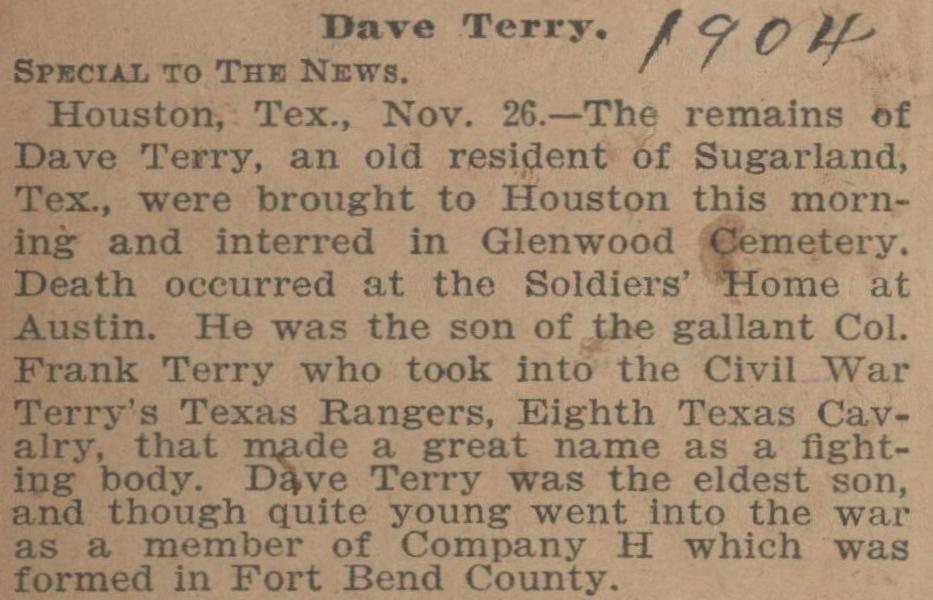
TERRY, BENJAMIN FRANKLIN (1821–1861).


Burial: Glenwood Cemetery Houston, Harris County, Texas, USA, Plot: Section E-1
The rangers were sworn into service in September, but Terry delayed their final organization until late November, when they were officially designated the Eighth Texas Cavalry. The regiment started immediately for Virginia but en route was diverted to Nashville and then later ordered to Bowling Green, Kentucky. Terry was killed in the first battle fought by the rangers near Woodsonville, Kentucky, on December 17, 1861. The battle, however, abruptly ended in a Confederate victory. Terry's body was sent by train to Nashville, Tennessee, where the legislature adjourned and joined in a procession escorting the remains to be held in state at the Tennessee Capitol. The body lay in state in New Orleans and then Houston, where the funeral procession was described as "the most imposing ever seen in this state." Governor Lubbock lauded Terry in the state Senate: "no braver man ever lived-no truer patriot ever died." Terry County was later named in his honor.
On December 17 th Terry Rangers were at a place called Woodsonville, Kentucky on the Green River. They were fired on by an enemy concealed in a near-by woods when the colonel ordered a charge and led it across a field towards the woods. Riding in the lead mounted on a superb horse, [B. F. Terry] standing in his stirrups was the embodiment of chivalry. A soldier concealed behind a stack of fodder shot him as he passed and he fell in the very first skirmish. They brought him home at Christmas and laid him to rest at the family burying ground on the Oakland plantation.
Clem Basset long years after told John M. Moore that they captured a German-American soldier who was suppose to have fired the shot and that his captors allowed young David [oldest son of B. F. Terry] to shoot him.
Clarence Wharton's book History of Fort Bend County page 171
In May of 1880 the cemetery at Oakland Plantation was moved to Glenwood Cemetery in Houston.
Glenwood Cemetery shows the information for section E-1 lot 40;
Family links:
Spouse:
Mary Pickens Bingham Terry (1821 - 1876)*
Children:
Cornelia Terry Thatcher (____ - 1934)*
David Smith Terry (1843 - 1904)*
Sarah Terry
(1845 - 1846)*
Mary Terry Smith (1847 - 1925)*
Benjamin Franklin Terry (1850 - 1869)*
Sally Terry Thatcher (1853 - 1878)*
Jefferson Kyle Terry (1855 - 1890)*
Benjamin Franklin Terry was raised on the Chenango Plantation
B. F. Terry's relatives buried at Sandy Point Cemetery are;
Terry, Aurelius J. [abt. 1828] --- 1869 Married Miss Lucy GAUTIER December 15, 1864 in Brazoria County. Military marker. VETERAN OF MEXICAN & CIVIL WARS. BORN IN HINDS COUNTY, MISS. DIED IN HOUSTON IN 1869.
Terry, Clinton Thursday, June 30, 1831 --- Sunday, April 06, 1862 Military Marker Clinton Lucretius Terry, the son of Joseph R. Terry and Sarah D. (Smith) Terry, was born June 30, 1831, in Clinton, Hines County, Mississippi. He was a brother of Benjamin Franklin Terry. CLINTON TERRY Born Hinds County, Miss. In 1821 "Was mortally wounded at Shiloh April 6, 1862, while gallantly leading a charge of Terry's Rangers."
Terry, Winifred F. Thursday, October 26, 1837 --- Thursday, January 23, 1862 Winifred was the first wife of Aurelius J. Terry. Clinton M. was their daughter.
Terry, Clinton M. Friday, November 30, 1855 --- Saturday, March 07, 1868
Sandy Point Cemetery records are here.
Since Kyle Terry died in 1890 before David Terry, who died in 1904, the second plot at Glenwood was purchased for Kyle. There is not a marker for Kyle. David has a marker and it is the only marker on this plot. Glenwood Cemetery [Actually it is Findagrave.com record that is incorrect] indicates that Kyle and David are buried in section E-1 lot 40. They are not.
Jefferson Kyle TERRY was born on 26 December 1855 in, Brazoria, TX. He died on 21 January 1890 at the age of 34 in Galveston, TX., murdered at his own trial for murder; shot during "Jaybird Woodpecker Wars."
Kyle Terry - A Texas gunman, Terry killed Henry Williams in February, 1886 in Houston,
Texas, shotgunned Ned Gibson on Jan. 21, 1888, at Wharton. Volney Gibson shot and killed Terry on Jan. 21, 1890, in Galveston. -www.legendsofamerica.com

EIGHTH TEXAS CAVALRY
The Eighth Texas Cavalry — or, as it was frequently known, the First Texas Rangers or Terry's Texas
Rangers — wasmustered into Confederate service at Houston, Texas, September 9, 1861. Almost all of the
officers and many of the enlisted men of the command had seen prior service in the TexasRangers. Although
the unit had been mustered into service in September, 1861,the numerical designation was not given until
the following spring, when the regiment was at Bowling Green, Kentucky.
"H" recruited from Harris and Fort Bend Counties
Similar to almost all Civil War units, the Eight Texas Cavalry was often known by an alternate designation
derived from the name of the unit's commanding officer. Unofficial, alternate names of this type identified as
Leander Lubbock’s Calvary for Company “H”.
The Eighth Texas Cavalry was one of the most frequently engaged of all Confederate cavalry units in the Civil
War.Records have been found locating the unit at well over one hundred and fifty various type skirmishes,
engagements, battles, etc . during its career.
Historical Research Center, Texas Heritage Museum
Fort Bend County in the Fall of 1861
Fort Bend County was settled in the 1820's as part of Austin's Colony, and developed along thefertile
bottomlands of the Brazos River. By I860, Fort Bend County was the second most prosperous county in
Texas behind Harris County. The population was2,016 whiteresidents and 4,127 slaves in the county. The
plantation culture was dominant throughout the area—more so than virtually any other area of Texas.
When other southern states felt compelled to secede from the Union and form the Confederate States of
America in order to protect what they, felt were their rights, there was sufficient clamor among Texans for
similar action that a Secessionist Convention of representatives from all areas of Texas was called in early
1861.Citizens of Fort Bend County elected Benjamin Franklin Terry, who asactive in local political affairs and
owner of the Oakland sugar plantation (now the town of Sugar Land and the basis for the ImperialSugar
Company). During the February, 1861 election to ratify the Ordinance ofSecession, Fort Bend County
voted unanimously in favor of secession.
In late February, 1861, Terry was selected to command a battalion of troops sent to reinforce Col.John S.
Ford in his efforts to capture the Federal forts and posts along the Rio Grande. These troopswere armed by
E. B. Nichols with 250 stands of U.S. muskets from the Louisiana arsenal at Baton Rouge and equipped
withcartridge boxes and belts from the same source. Among the 300 men that departed with Terry on the
steamer General Rusk were 75 men of the Fort Bend Rifles. Captain Daniel Conner commanded the Fort
Bend Rifles, who while on thisexpedition were mounted onlocally-purchased horses and posted to guard
Boca Chico Pass, while the mainforce besieged Fort Brown. Ford's command was equipped from the store of
ordnance and quartermasters' supplies capturedin the Rio Grande expedition. Of particular note was a
large quantity of artillery pieces, limbers, caissons, a battery wagon, a forgeand related supplies captured
for use by the Texas state troops. The command,successful in its efforts, returned to Galvestonon the same
ship on March 15, and the troops returned by train to Houston and Richmond.
Recruiting of Terry's Texas Rangers
Terry joined Thomas S. Lubbock and Thomas J. Goree in a journey to the East coast to appeal for a commission to raise a cavalry regiment. These three Texans served as volunteer aides on the staff of James Longstreet at the Battle of Manassas in July, 1861. In recognition of their battlefield exploits, Terry and Lubbock received commissions to raise a cavalry regiment for service in Virginia. In early August the two leaders were back in Texas, and commissioned ten captains to each raise a company ofcavalry. Captain John Holt was to raise a company, called the Terry Guards—later Company H, from Fort Bend County.
The call to arms stipulated that each man should furnish his own gear, including rifle or shotgun, oneor more
revolvers, saddle, bridle, etc. Double-barrel shotguns composed 597 of the 773long arms with which the
regiment mustered, supplemented by 579 Navy Coltrevolvers, 92 Army Colt revolvers, 65 "5-Shot" Colt
revolvers, 22 horse pistols, and 11 Starr revolvers. Terry carried a sword used in theWar of 1812—and is listed as
having the only sword—the remainder having belt orbowie knives.
One soldier commented: "The personnel was of the very highest. Sons of leading families,many of them
college graduates, professional men, merchants, stockmen, and farmers, served in the ranks as privates^ all
young, in their teens and earlytwenties. Rank was scarcely considered. The supreme desire was to get into the
war in a crackcavalry regiment." Terry and his officers hand-picked each memberof the regiment—it being early
in the war and membership in this unit so desirable that any man who did not meet the expectations of the
recruiter was simply refused theprivilege of enlistment.
Once recruited, the companies elected their other officers and noncommissioned officers. Followingsend-offs from
the local areas, the companies assembled in Houston where they were mustered into Confederate service in
September, 1861. "A little incident happened at the time which showed the feelings and determination of the men.
They werelined upon three sides of a hollow square (as I now remember). The enrollingofficer in the center asked
this question, 'Do you men wish to be sworn into service for twelve months or for three years or for during the war?'
With aunanimity never surpassed, a shout unheard of before, that whole body of men shouted, 'For thewar,' 'For the
warl' not one expecting or caring to return until the war was over,long or short, and the invaders had been driven from
our borders."
Members of Company H included:
John T. Holt, Captain, age 36 Tom S. Weston, 1stLieutenant, age 24 Robert Calder, 2nd
Lieutenant, age 22 William D. Adams,3rd Lieutenant, age 33 Gustave Cook, 1st Sergeant, age 27
Robert J. Hodges, 2nd Sergeant, age 25 Jesse Thompson, 3rd Sergeant, age 42 Johnson C.
Williams, 4th Sergeant, age 23 James Edmondson, 5th Sergeant, age 28 Eugene Griffin,1st
Corporal, age 24 Edward A. Bolines/Bolmes, 2nd Corporal, age 24 Thomas D.Barrington, 3rd
Corporal, age 23 David S. Terry, 4th Corporal, age 19
Historical Research Center, Texas Heritage Museum
TERRY, BENJAMIN FRANKLIN (1821–1861).
Benjamin Franklin (Frank) Terry, organizer and first commander of the Eighth Texas Cavalry (Terry's Texas Rangers) in the Civil War, was born on February 18, 1821, in Russellville, Kentucky, the son of Joseph R. and Sarah D. (Smith) Terry and the older brother of David Smith Terry. His grandfathers, Nathaniel Terry and David Smith, had been officers in the Revolutionary War, and the latter also served under Andrew Jackson in the War of 1812. While Terry was still a child his parents moved to Mississippi and separated. The 1830 census of Hinds County, Mississippi, enumerated the Terry household as Sarah Terry, five male children, and eight slaves. In 1833 or early 1834 Sarah Terry moved to Texas and settled with her brother, Maj. Benjamin Fort Smith, in Brazoria County. Sarah Terry died a few years later; in 1837 her brother was appointed guardian of the children and administrator of her estate, which consisted of over 2,000 acres of land fronting the Brazos River and eighteen slaves. Ben F. Smith then died in 1841, and young Frank Terry assumed responsibility for managing the family plantation. On October 12, 1841, Terry married Mary Bingham, daughter of Francis Bingham, one of Stephen F. Austin's Old Three Hundred colonists in Texas. The couple had three sons and three daughters. On March 6, 1844, the Houston Telegraph reported that two insurgent slaves attacked Terry on his plantation with knives and axes, but "with admirable courage" he defended himself and managed to disable both men. Terry formed a partnership with William J. Kyle, and in 1851 they were awarded a contract to construct the first railroad in Texas, the Buffalo Bayou, Brazos and Colorado Railway, from Harrisburg, a small hamlet five miles from Houston, to the Brazos River and beyond to Richmond. Terry and Kyle used slave labor in the construction, which cost $18,400 per mile, but it was not until January 1856 that the tracks reached the Brazos some thirty miles from Harrisburg. Due to the railroad, however, a brisk trade began to move to Harrisburg. Houston was not to be outdone and received authorization from the state to finance a railroad and approval from its taxpayers to build the Houston Tap, as it was called, to connect with the Buffalo Bayou, Brazos and Colorado Railway at a point eight miles from Harrisburg. Terry and Kyle were also awarded the contract to build the Houston Tap. Terry had also purchased the Oakland sugar plantation in Fort Bend County in 1852 and became a prosperous sugar planter. In 1860 he and Kyle had real and personal property worth almost $300,000.
By reason of his wealth, large physical size, and popularity, Frank Terry became a leader in Fort Bend County, and on January 9, 1861, he was elected a delegate to the Secession Convention in Austin. Terry and two fellow delegates, Thomas S. Lubbock and John A. Wharton, conceived the idea of organizing at least one company of Texas cavalrymen for the new government. In February and March of 1861 Terry was one of the senior officers aiding John Salmon Ford and Ebenezar B. Nichols in the campaign to disarm the federal troops at Brazos Santiago. In June 1861 Terry, Lubbock, Wharton, and perhaps as many as fifty other Texans sailed from Galveston to New Orleans and then caught the train to Richmond to offer their services to the Confederate Army. In Richmond Terry and Lubbock secured positions as volunteer aides to Gen. James Longstreet. Both men were appointed colonel, a term attached as a courtesy for their volunteer service, and participated with distinction in the battle of First Manassas or Bull Run. Afterward, the Confederate War Department granted the authority to organize a cavalry regiment. At Houston on August 12, 1861, Terry and Lubbock issued a call for volunteers that was answered by 1,170 men. The rangers were sworn into service in September, but Terry delayed their final organization until late November, when they were officially designated the Eighth Texas Cavalry. The regiment started immediately for Virginia but en route was diverted to Nashville and then later ordered to Bowling Green, Kentucky. Terry was killed in the first battle fought by the rangers near Woodsonville, Kentucky, on December 17, 1861. The battle, however, abruptly ended in a Confederate victory. Terry's body was sent by train to Nashville, Tennessee, where the legislature adjourned and joined in a procession escorting the remains to be held in state at the Tennessee Capitol. The body lay in state in New Orleans and then Houston, where the funeral procession was described as "the most imposing ever seen in this state." Governor Lubbock lauded Terry in the state Senate: "no braver man ever lived-no truer patriot ever died." Terry County was later named in his honor.
James Knox Polk Blackburn, Reminiscences of Terry's Texas Rangers (Austin: Littlefield Fund for Southern History, University of Texas, 1919; rpt., Austin: Ranger Press, 1979). Zachary T. Fulmore, History and Geography of Texas As Told in County Names (Austin: Steck, 1915; facsimile, 1935). Andrew Forest Muir, "Railroads Come to Houston, 1857–1861," Southwestern Historical Quarterly 64 (July 1960).